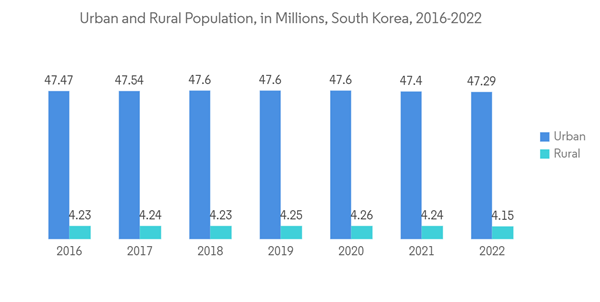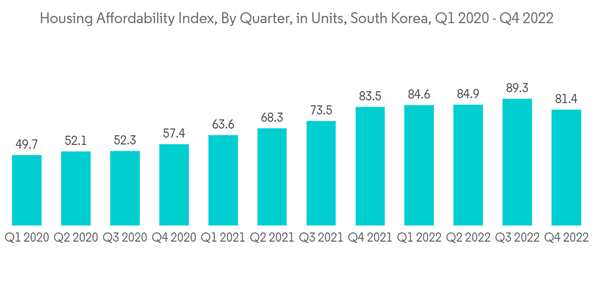The increasing housing demand drives the market. Furthermore, the market is driven by the increasing construction of apartments in the country due to land scarcity.
Key Highlights
- The COVID-19 pandemic brought a huge difference in the residential real estate market in South Korea. The number of private apartments sold in Seoul from January 2021 to July 2021 was 1,895 units, a decrease of 86% from the same period last year (13,782 units), while in the metropolitan area, 40,876 households were sold during the same period.
- In January 2021, South Korea's finance ministry prioritized increasing housing supply, with construction regulations in heavily crowded urban areas relaxed and redevelopment projects supported to stabilize and drive the housing market. Further, the government announced its plan to develop 830,000 housing units nationwide, including 320,000 units in Seoul, in two years. In Asia, South Korea has developed its green building certification system, the Green Standard for Energy and Environmental Design (G-SEED), which assesses the eco-friendliness of buildings by evaluating eight environmental areas.
- High-rise apartments, detached homes, and row houses are Korea's primary housing types. In South Korea, apartments are the most prevalent type of housing. These flats are frequently located in residential high-rise structures with five to twenty levels. The most popular form of housing for South Koreans is an apartment since the neighbourhood is readily constructed around the apartment complex. An apartment complex often houses hundreds to thousands of households with retail stores, recreation areas, and childcare facilities. Nevertheless, detached homes are becoming more popular as it has become more fashionable to live outside cities.
South Korea Residential Real Estate Market Trends
Urbanization in the Country is Driving the Market
- Asia-Pacific is urbanizing faster than Europe and North America. It will likely continue to have most of the world's megacities (urban agglomeration areas with a population of over 10 million). The rapid industrialization that Korea experienced has accelerated migration patterns and demographic trends from rural to urban areas. Due to the increasing population, the country has experienced unbalanced land distribution and demographic patterns.
- Rapid urbanization, demographic changes, and technological advancements are trends driving cities' residential real estate market. These factors contributed to the rising house prices, affordable housing shortages, and limited housing stock in many cities. These problems, in turn, threaten not just financial market stability but also the quality of life and integration and city competitiveness on the national and international scale.
- In response, the cities are focusing on creating more housing, including a more diverse range of options for the housing stock to meet the needs of different types and income levels of households. Further, through applying the principles of 'good density, ' integrated urban environments can be created with high-quality placemaking that cater to a range of income and population groups and contribute to the vibrancy and authenticity of a city.
Affordable Housing Supply in the Country
- South Korea ranked third from the bottom, with a property affordability score of 3.94 (in December 2021). With relatively low salaries and high apartment costs, South Koreans may find it challenging to afford houses.
- As reported in February 2021, South Korea planned to supply 830,000 housing units in Seoul and other big cities in two years through housing redevelopment projects led by state-run agencies, marking the largest-scale supply measure envisioned by the Moon Jae-in administration. Of the 830,000 housing units, 323,000 new houses will be built in Seoul and 293,000 in the Gyeonggi Province and Incheon. The ministry also plans to add over 220,000 new homes in major cities, including Busan, Daegu, and Daejeon, which saw hikes in property prices.
- Additionally, the Ministry of Land, Infrastructure and Transport announced its real estate plan to provide affordable housing in big cities to meet the demand from young people and tackle soaring home prices. The focal point of the new measure is to have public developers, such as the state-run Korea Land and Housing and Seoul Housing and Communities create fast-track approval processes to expand the housing supply swiftly.
South Korea Residential Real Estate Industry Overview
The South Korea Residential Real Estate Market is fragmented, with many regional and local players and a few global companies. Public services mostly dominate the housing or residential development in South Korea. Government agencies, such as the Korea National Housing Corporation and the Korea Land Development Corporation, primarily undertake housing developments in Korea. Dongbu Corporation, Hines, Shinyoung (Greensys), Korea Land and Housing Corporation, Booyoung Group, and HDC Hyundai Development are prominent players in the market. Growing residential and affordable house construction in the country generates several opportunities for companies in the industry.Additional Benefits:
- The market estimate (ME) sheet in Excel format
- 3 months of analyst support
This product will be delivered within 2 business days.
Table of Contents
Companies Mentioned (Partial List)
A selection of companies mentioned in this report includes, but is not limited to:
- Hyosung Corporation
- Dongbu Corporation
- Daelim Corporation
- Booyoung Group
- Korea Land and Housing Corporation
- ShinYoung Greensys
- Hyundai Development Company
- Hines
- Knight Frank
- Cushman And Wakefield*
Methodology

LOADING...










